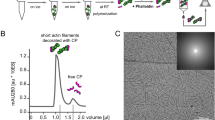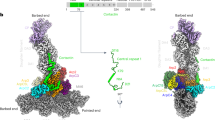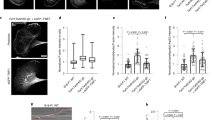Abstract
The Arp2/3 complex is an essential regulator of actin polymerization in response to signalling and generates a dendritic array of filaments in lamellipodia. Here we show that the activated Arp2/3 complex interacts with the barbed ends of filaments to initiate barbed-end branching. Barbed-end branching by Arp2/3 quantitatively accounts for polymerization kinetics and for the length correlation of the branches of filaments observed by electron microscopy. Filament branching is visualized at the surface of Listeria in a reconstituted motility assay. The functional antagonism between the Arp2/3 complex and capping proteins is essential in the maintenance of the steady state of actin assembly and actin-based motility.
This is a preview of subscription content, access via your institution
Access options
Subscribe to this journal
Receive 12 print issues and online access
$209.00 per year
only $17.42 per issue
Buy this article
- Purchase on SpringerLink
- Instant access to full article PDF
Prices may be subject to local taxes which are calculated during checkout






Similar content being viewed by others
References
Loisel, T. P., Boujemaa, R., Pantaloni, D. & Carlier, M-F. Reconstitution of actin-based motility of Listeria and Shigella using pure proteins. Nature 401, 613–616 (1999).
Borisy, G. G. & Svitkina, T. M. Actin machinery: pushing the envelope. Curr. Opin. Cell Biol. (in the press).
Theriot, J. A. & Mitchison, T. J. Actin microfilament dynamics in locomoting cells. Nature 352, 126– 131 (1991).
Theriot, J. A., Mitchison, T. J., Tilney, L. G. & Portnoy, D. A. The rate of actin-based motility of intracellular Listeria monocytogenes equals the rate of actin polymerization. Nature 357, 257–260 (1992).
Welch, M. D., Rosenblatt, J., Skoble, J., Portnoy, D. A. & Mitchison, T. J. Interaction of human Arp2/3 complex and the Listeria monocytogenes ActA protein in actin filament nucleation. Science 281, 105–108 ( 1998).
Machesky, L. M. & Insall, R. H. Scar1 and the related Wiskott–Aldrich syndrome protein WASP regulate the actin cytoskeleton through the Arp2/3 complex. Curr. Biol. 8, 1347–1356 (1998).
Machesky, L. M. et al. Scar, a WASp-related protein, activates dendritic nucleation of actin filaments by the Arp2/3 complex. Proc. Natl Acad. Sci. USA 96, 3739–3744 (1999).
Rohatgi, R. et al. The interaction between N-WASP and the Arp2/3 complex links Cdc42-dependent signals to actin assembly. Cell 97, 221–231 (1999).
Yarar, D., To, W., Abo, A. & Welch, M. D. The Wiskott–Aldrich syndrome protein directs actin-based motility by stimulating actin nucleation with the Arp2/3 complex. Curr. Biol. 9, 555–558 (1999).
Winter, D., Lechler, T. & Li, R. Activation of the Arp2/3 complex by Bee1p, a WASP-family protein. Curr. Biol. 9, 501–504 ( 1999).
Egile, C. et al. Activation of the Cdc42 effector N-WASP by the Shigella IcsA protein promotes actin nucleation by Arp2/3 complex and bacterial actin-based motility. J. Cell Biol. 146, 1319 –1332 (1999).
Small, J. V. Getting the actin filaments straight: nucleation–release or treadmilling Trends Cell Biol. 5, 52–55 (1995).
Carlier, M-F. Control of actin dynamics . Curr. Opin. Cell Biol. 10, 45– 51 (1998).
Svitkina, T. M. & Borisy, G. G. Arp2/3 complex and actin depolymerizing factor ADF/cofilin in dendritic organization and treadmilling of actin filament array in lamellipodia. J. Cell Biol. 145, 1009–1026 ( 1999).
Mullins, R. D., Heuser, J. A. & Pollard, T. D. The interaction of Arp2/3 complex with actin: nucleation, high affinity pointed end capping and formation of branched networks of filaments . Proc. Natl Acad. Sci. USA 95, 6181– 6186 (1998).
Higgs, H. N., Blanchoin, L. & Pollard, T. D. Influence of the C terminus of Wiskott–Aldrich Syndrome Protein (WASp) and the Arp2/3 complex on actin polymerization. Biochemistry 38, 15212–15222 (1999).
Higgs, H. N. & Pollard, T. D. Regulation of actin polymerization by Arp2/3 complex and WASp/Scar proteins. J. Biol. Chem. 274, 32531–32534 ( 1999).
Carlier, M-F., Pantaloni, D. & Korn, E. D. Polymerization of ADP–actin and ATP–actin under sonication and characteristics of the ATP–actin equilibrium polymer. J. Biol. Chem. 260, 6565–6571.
Halsey, T. C. Diffusion-limited aggregation as branched growth. Phys. Rev. Lett. 72, 1228–1231 ( 1994).
Schafer, D. A. & Cooper, J. A. Control of actin assembly at filament ends. Annu. Rev. Cell Dev. Biol. 11, 497–518 (1995).
Sun, H. Q., Yamamoto, M., Mejillano, M. & Yin, H. L. Gelsolin, a multifunctional actin regulatory protein. J. Biol. Chem. 274, 33179–33182 ( 1999).
Laine, R. O. et al. Gelsolin, a protein that caps the barbed ends and severs actin filaments, enhances the actin-based motility of Listeria monocytogenes in host cells. Infect. Immun. 66, 3775 –3782 (1998).
Cunningham, C., Stossel, T. P. & Kwiatkowski, D. Enhanced motility in NIH 3T3 fibroblasts that overexpress gelsolin. Science 251, 1233– 1236 (1991).
Hug, C. et al. Capping protein levels influence actin assembly and cell motility in Dictyostelium. Cell 81, 591– 600 (1995).
Sun, H., Kwiatkowska, K., Wooten, D. & Yin, H. Effects of CapG overexpression on agonist-induced motility and second messenger generation . J. Cell Biol. 129, 147– 156 (1995).
Carlier, M.-F. & Pantaloni, D. Control of actin dynamics in cell motility. J. Mol. Biol. 269, 459–467 (1997).
Ressad, F., Didry, D., Egile, C., Pantaloni, D. & Carlier, M-F. Control of actin filament length and turnover by actin depolymerizing factor (ADF/cofilin) in the presence of capping proteins and Arp2/3 complex J. Biol. Chem. 274, 20970–20976 ( 1999).
Carlier, M-F., Ressad, F. & Pantaloni, D. Control of actin dynamics in cell motility. Role of ADF/cofilin. J. Biol. Chem. 274, 33827–33830 (1999).
Gouin, E. et al. A comparative study of the actin-based motilities of the pathogenic bacteria Listeria monocytogenes, Shigella flexneri and Rickettsia conorii. J. Cell Sci. 112, 1697– 1708 (1999).
Huang, M. et al. Cdc42-induced actin filaments are protected from capping protein . Curr. Biol. 9, 979–982 (1999).
Kouyama, T. & Mihashi, K. Fluorimetry study of N-1-pyrenyl-iodoacetamide-labeled F-actin. Eur. J. Biochem. 114, 33– 38 (1981).
Pantaloni, D. & Carlier, M-F. How profilin promotes assembly of actin filaments in the presence of thymosin β4. Cell 75, 1009 –1014 (1993).
Kuhlmann, P. A. & Fowler, V. M. Purification and characterization of an α1β2 isoform of CapZ from human erythrocytes: cytosolic location and inability to bind to Mg++ ghosts suggest that erythrocyte actin filaments are capped by adducin. Biochemistry 36, 13461–13472 ( 1997).
Casella, J. F., Maack, D. J. & Lin, S. Purification and initial characterization of a protein from skeletal muscle that caps the barbed ends of actin filaments. J. Biol. Chem. 261, 10915–10921 (1986).
Pollard, T. D. & Cooper, J. A. Actin and actin-binding proteins. A critical evaluation of mechanisms and functions. Annu. Rev. Biochem. 55, 987–1035 (1986).
Laurent, V. et al. Role of proteins of the Ena/VASP family in actin-based motility of Listeria monocytogenes. J. Cell Biol. 144, 1245–1258 (1999).
Acknowledgements
This work was funded in part by the Association pour la Recherche contre le Cancer (ARC), the Association Française contre les Myopathies (AFM) and the Ligue Nationale Française contre le Cancer, and by a grant from the Human Frontier in Science programme organization.
Correspondence and requests for materials should be addressed to M-F.C.
Author information
Authors and Affiliations
Corresponding author
Supplementary information
Movie 1
Evidence of barbed-end branching in bacterial actin-based motility. (MOV 106 kb)
pActin-based motility of Listeria was observed in reconstituted motility medium modified by replacement of capping protein with gelsolin at a gelsolin/actin ratio of 1:500 (8 mM F-actin, 16 µM gelsolin). This time-lapse recording shows branched actin filaments continuing to grow immediately behind the bacterium at a 70° angle to the actin-tail axis.
Rights and permissions
About this article
Cite this article
Pantaloni, D., Boujemaa, R., Didry, D. et al. The Arp2/3 complex branches filament barbed ends: functional antagonism with capping proteins. Nat Cell Biol 2, 385–391 (2000). https://doi.org/10.1038/35017011
Received:
Revised:
Accepted:
Published:
Issue Date:
DOI: https://doi.org/10.1038/35017011



